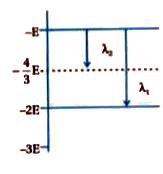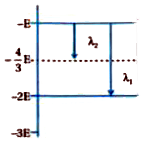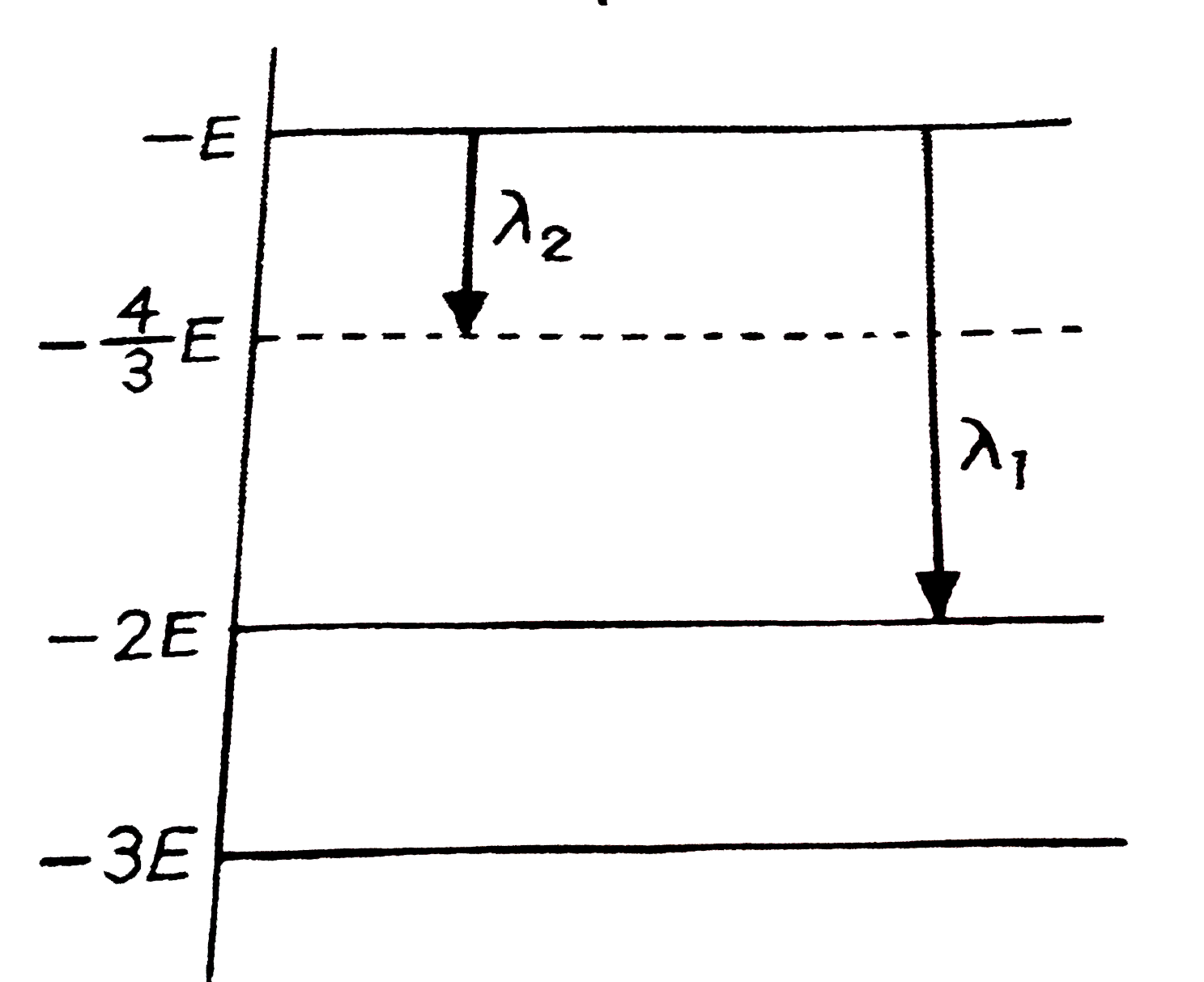Some energy levels of a molecule are shown the figure. The ratio of the wavelength r=λ1λ2 is given by …………..
 Solution in Gujrati
Solution in Gujrati
r=34
r=13
r=43
r=23
The correct Answer is:B
−E−(−2E)=hcλ1
∴E=hcλ1 ......(1)
and −E−(−43E)=hcλ2
∴E3=hcλ2 ......(2)
Dividing equation (2) by equation (1).
13=λ1λ2
∴13=r

Topper's Solved these Questions
- ATOMSBOOK - KUMAR PRAKASHANCHAPTER - ATOMSEXERCISE - Section-D -MCQs asked in AIIMS
17 Videos
- ATOMSBOOK - KUMAR PRAKASHANCHAPTER - ATOMSEXERCISE - Section-D -MCQs asked in GUJCET / Board Exam
34 Videos
- ATOMSBOOK - KUMAR PRAKASHANCHAPTER - ATOMSEXERCISE - Section-D (Multiple Choice Questions (MCQs)) (MCQs From .DARPAN Based On Textbook) (MCQs based on Textual Illustrations and Exercise )
11 Videos
- ALTERNATING CURRENTS BOOK - KUMAR PRAKASHANCHAPTER - ALTERNATING CURRENTS EXERCISE - SECTION-D MCQs (COMPETITIVE EXAMS)
64 Videos
- BOARD'S QUESTION PAPER MARCH-2020 BOOK - KUMAR PRAKASHANCHAPTER - BOARD'S QUESTION PAPER MARCH-2020 EXERCISE - PART-B SECTION -C
4 Videos
Similar Questions
Characteristic X-rays are produced due to ....
View SolutionThe ratio of longest wavelength and the shortest wavelength observed in the 5 spectral series of emission spectrum of hydrogen is .......
View SolutionAccording to the classical electromagnetic theory, calculate the initial frequency of the light emitted by the electron revolving around a proton in hydrogen atom.
View SolutionPower factor of AC series circuit having resistance R and inductor L having angular frequency ω is ……..
View SolutionDerive an expression for current I passing through an AC circuit containing only inductor L. Draw a Phasor diagram and graph of v and I versus ωt. Explain instantaneous power and the average power.
View SolutionSome energy levels of a molecule are shown in the fig. The ratio of the wavelengths r=lambda_(1)//lambda_(2) , is given by
View SolutionThe wavelength of the first Lyman lines of hydrogen He^(+) and Li^(2+) ions and lamda_(1),lamda_(2)& lamda_(3) the ratio of these wavelengths is
View SolutionA proton has kinetic energy E = 100 keV which is equal to that of a photon. The wavelength of photon is lamda_(2) and that of proton is lamda_(1) . The ratio of lamda_(2)//lamda_(1) is proportional to
View SolutionA dye absorbs a photon of wavelength lamda and re-emits the same energy into two photns of wavelength lamda_(1) and lamda_(2) respectively. The wavelength lamda is related to lamda_(1) and lamda_(2) as :
View SolutionSome energy levels of a molecule are shown in the figure. The ratio of the wavelength r=lamda_(1)lamda_(2) ,is given by:
View Solutionएक अणु के कुछ ऊर्जा-स्तरों को चित्र में दिखाया गया है। तरंगदैर्घ्यों के अनुपात r=λ1/λ2 का मान होगा :

View SolutionIn a biprism experiment, if the 6th bright bannd with a wavelength λ1 coincides with 7th dark band with a wavelength λ2, then the ratio of the wavelengths (λ1λ2) is
View SolutionIf λ1andλ2 are the wavelengths of the first members of the Lyman and Paschen series respectively, then λ1:λ2 is
View SolutionThe energy of a photon is equal to the kinetic energy of a proton. If λ1 is the de-Broglie wavelength of a proton, λ2 the wavelength associated with the proton and if the energy of the photon is E, then (λ1/λ2) is proportional to
View SolutionFor Balmer series, wavelength of first line is lamda_(1) and for Brackett series, wavelength of first line is lamda_(2) then (lamda_(1))/(lamda_(2))
View Solution
